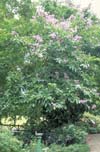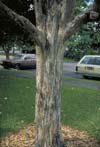Home >
Lagerstroemia speciosa,
Queen's Crapemyrtle
Queen's Crapemyrtle will grow in full sun on a wide range of well-drained soils but is not salt-tolerant. The tree should tolerate storms well having hard wood with flexible branches, as long as they are well spaced along the trunk and not clumped together growing from one point on the trunk. Plants should be protected from frost.
Not a tree to plant and forget, Queen's Crapemyrtle appreciates regular fertilization or leaves become chlorotic. It will tolerate alkaline soil with regular fertilizer applications. This plant is considered mostly allergy free and causes little or no allergy problems in most people. Trees receive moderate to light damage in hurricanes compared to other tropical trees.
Clear all turf away from beneath the branches and mulch to the drip line, especially on young trees, to reduce competition with turf and weeds. This will allow roots to become well established and keep plants healthier. Prune the tree so trunks and branches will not rub each other. Remove some secondary branches on main branches with included bark. This reduces the likelihood of the main branch splitting from the tree later when it has grown to become an important part of the landscape. Locate the tree properly, taking into account the ultimate size, since the tree looks best if it is not pruned to control size. The tree can enhance any landscape with its delightful spring flush of foliage and flower display in summer. It can be the centerpiece of your landscape if properly located.





